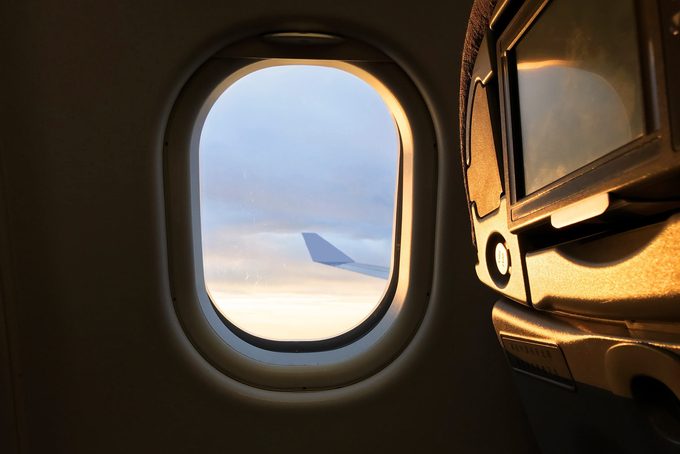
Reserve a window spot when you're traveling in coach.
If you're similar to many people, you often lack the airline miles or lucky breaks to snag an upgrade , so you’re going to be trying to doze off in a narrow economy-class seat without much legroom or space to recline. For many fliers in standard economy, booking a window seat is the best option for getting some sleep on a plane—it’s definitely something I try to nail down as soon as I buy my ticket. Why? It’s easier to fall asleep when I can rest my head on the window or wall, and I won’t be woken up by a fellow passenger headed to the bathroom. Plus, I’m in charge of the window shade.
The drawback, naturally, is that I might have to wake a sleeping seatmate When it's time to head to the restroom. Tip for being polite: If you anticipate needing to rise often to utilize the plane's lavatory, choosing an aisle seat is the most considerate option.
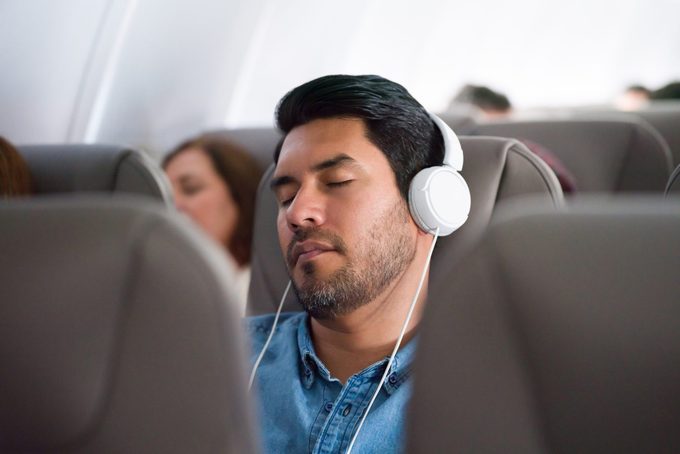
Pack sleep aids, particularly if your seat is in the middle.
So you ended up with the shortest straw and got stuck in the middle seat Dr. Kuhlmann emphasizes that now is the perfect moment to equip yourself with travel essentials designed for enhanced comfort during flights. Despite not being able to rest against the window or extend your legs into the aisle space, you can craft a snug environment that makes drifting off easier.
If you're really looking to catch some sleep during your flight, think about using noise-cancelling headphones or earplugs along with an eye mask. dressing in loose, breathable layers To enhance comfort and relaxation," suggests Dr. Kuhlmann. A travel pillow designed for neck support is essential when seated in the center position; this ensures you won’t have to rest your head on your neighbor's shoulder. Dr. Chasser advocates for the use of one. Cabeau Evolution S3 Travel Neck Pillow because of its memory-foam construction. I have this travel pillow and can attest to just how good it is: My family and I fight over it when we fly together.
A portable footrest that loops around the tray table is another item to consider. It may seem like a weird item, but think about how many times you’ve tried to brace a foot against the seat frame in front of you to keep from slipping down in your seat. With a footrest, your feet stay slightly elevated, mimicking a sleep position, and more importantly, they stay put—which translates to a much more comfortable flight.
These tips for how to sleep on a plane also work wonders for long-haul flights, no matter what type of seat you have.
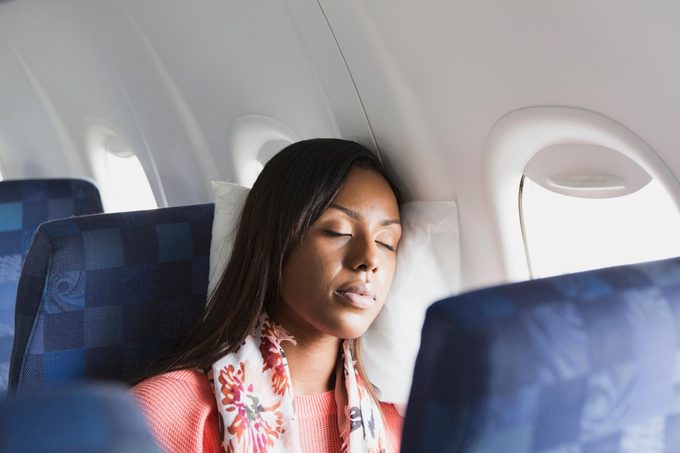
Take a power nap
"Short-haul flights offer a perfect chance to get some essential rest, which is beneficial for your memory and mental performance," explains Dr. Chasser. Additionally, as planes ascend into the air, cruising altitude , the cabin pressure decreases—indicating that the oxygen is somewhat thinner compared to sea level—which might cause drowsiness.
Her advice: If you're considering napping during a brief flight, limit your rest to under 20 minutes, ensuring it ends before 3 o'clock. "Following this approach refreshes you without causing drowsiness upon awakening," she explains. "It also won't interfere with your normal bedtime." She notes that even if slumber doesn't come easily mid-flight, engaging in just five minutes of intense relaxation or mindful breathing exercises can substantially decrease stress levels and enhance how well you sleep overall.
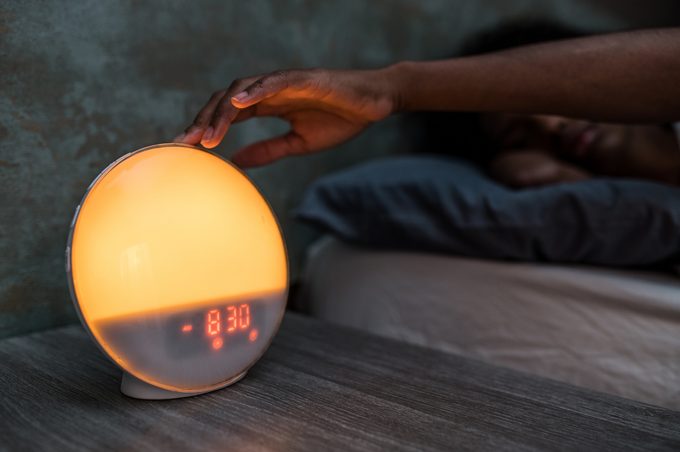
Give priority to sleep before a lengthy transcontinental trip.
We’re not just talking about the night before. Our experts say that your preparation for settling in on a long-haul flight should start days before you fly.
“When we cross time zones, our internal clock can struggle to keep up,” Dr. Chasser says. “It can only catch up by around an hour or so each day, although it tends to shift a bit quicker when flying from east to west—this is what makes traveling eastward harder.” If you’re flying into a new time zone, start adjusting your sleep schedule a few days before your flight, in gradual 20- to 30-minute intervals. This means creating an earlier or later bedtime or wake-up time, depending on which way you’re headed.
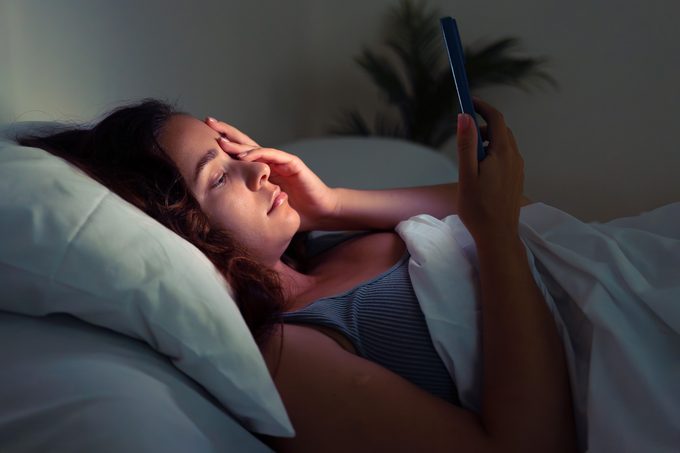
Limit your use of electronics
Specifically, avoid using electronic devices near bedtime—not only during the days leading up to your trip but also when you're on the airplane. "Blue light from screens tells your brain it's still day," says Dr. Kuhlmann. This can make it difficult to relax and prepare for sleep. If reading is part of your pre-flight routine, think about getting a blue-light filter for your handheld device.
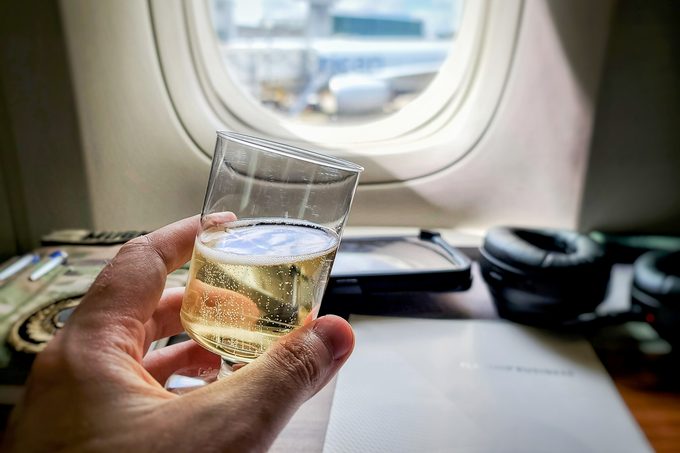
Avoid alcohol and caffeine
Dr. Chasser advises, "Those adorable mini bottles of liquor might seem appealing, but they're better left untouched if you want to enhance your sleep and deal with jet lag." According to her, although alcohol can make you feel drowsy, it significantly impairs the overall quality of your sleep, causing more interruptions during the night and reducing the effectiveness of your rest time. She recommends, "Should you desire an alcoholic drink, aim for at least six hours prior to bedtime and remember to keep yourself fully hydrated."
Dr. Kuhlmann notes that caffeine can similarly impair your sleep quality. "As a stimulant, it can interfere with your capacity to relax and may cause dehydration," he clarifies. It would be advisable to avoid it and opt for consuming ample amounts of water throughout your journey, both before, during, and post-flight.
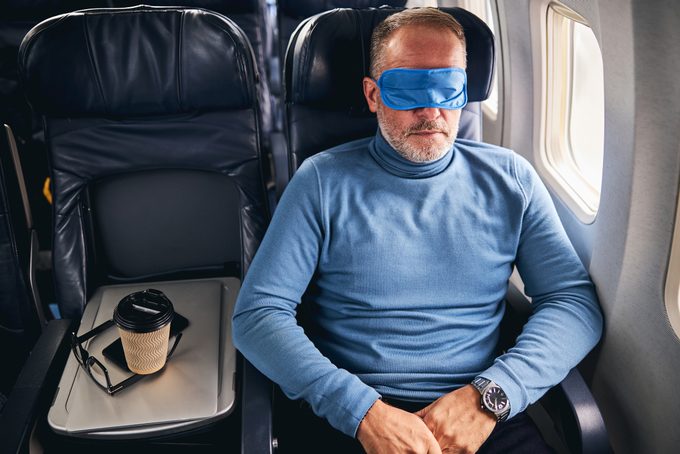
Bring a light-blocking eye mask
Whether it’s an open shade, interior lighting or your neighbor’s reading light, well-lit flights can prevent restful sleep. Want to know how to sleep on a plane with bright light? Just block it out. Dr. Chasser suggests investing in a soft, comfortable light-blocking eye mask, and she recommends the Kitsch Satin Sleep Mask , featuring a smooth wraparound design. Alternatively, you might consider using a lightly weighted sleep mask, which applies gentle pressure to aid in relaxing your nervous system.
An eye mask also signals to flight attendants that you don’t want to be disturbed. That means they won’t rouse you to see if you need a drink refill or some duty-free perfume.
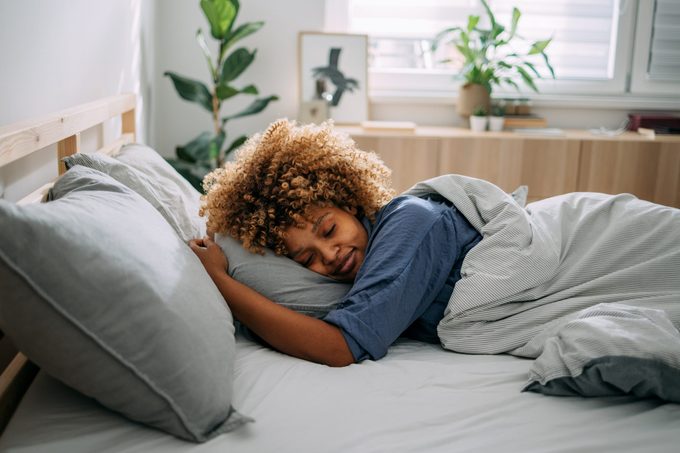
Adhere to your nightly regimen.
For Wetherall, who has journeyed extensively around the globe for her job, napping on planes revolves entirely around her routine. "Once it's bedtime," she explains, "I get ready as though I'm heading to bed at home." This involves brushing her teeth, cleansing her face (often with just a wipes), and slipping into cozy travel attire. Afterward, she wears an eye mask along with earplugs or noise-canceling headphones tuned to what she describes as "the dullest history podcast available."
Dr. Chasser concurs that feeling at ease is crucial, and this comfort also benefits your well-being. If you often cold on airplanes Make sure to wear layered clothing or carry a sweater with you. "Wearing warm bed socks or a beanie cap might aid in reducing your core body temperature by diverting more blood flow to the peripheral areas like hands and feet," she explains. "This diversion plays an essential role in indicating to your body that it's ready for sleep."

Opt out of the in-flight meal
If you’d like fewer sleep interruptions (and who wouldn’t?), consider skipping the in-flight meal, especially on overnight flights. I fly frequently between Italy and the U.S., and my flight to Italy is always an overnighter. But with the time change, I lose six hours en route. I board in the early evening and arrive in Italy early the next morning, usually with an eight-hour flight time. If I wait for the in-flight meal (which, let’s face it, is usually not great anyway) and for my tray to be collected afterward, two hours can easily go by.
Instead, I’ve learned to have dinner in the airport before boarding (or at an airport lounge when I can swing it). That way, I can settle into sleep as soon as the wheels go up. With my travel pillow and eye mask in place, the flight attendants don’t even bother asking me if I’d prefer chicken or pasta!

Consider a sleep aid
Certain flyers waste no time addressing their needs by using sleep aids to doze off during the flight. As for Wetherall, they opt for either a CBD gummy (if permitted), melatonin, or a Tylenol PM, "based on just how desperate I feel!"
Dr. Chasser says that melatonin can definitely help you sleep on a plane, especially when you time your dose. “Melatonin is the hormone that helps your body know when it’s time to sleep and wake up. If you’re flying west and find you wake too early, taking a melatonin supplement in the morning upon waking can help you sleep in a bit longer and help adjust your body clock.” On the other hand, she says, if you’re flying east, take melatonin about 30 minutes before (what would be) bedtime at your destination. “It not only nudges your body clock earlier, but it also has a mild sedative effect that will help you drift off.”
Dr. Kuhlmann adds that the melatonin you take should be the short-acting variety, rather than a time-release version. Look for packaging labeled “fast-acting,” “instant” or similar.
About the experts
|
Why trust us
Reader’s Digest has published hundreds of travel stories that help readers explore the world safely, easily and affordably. We regularly cover topics such as the best places to visit (and the best times to visit them), tips and tricks to zoom through airport security, flight-attendant secrets, hotel-room hacks and more. We’re committed to producing high-quality content by writers with expertise and experience in their field in consultation with relevant, qualified experts. We rely on reputable primary sources, including government and professional organizations and academic institutions as well as our writers’ personal experiences where appropriate. For this piece on how to sleep on a plane, Elizabeth Heath tapped her experience as a longtime travel journalist to ensure that all information is accurate and offers the best possible advice to readers. Read more about our team , our contributors and ourselves editorial policies .
Sources:
- David Kuhlmann , who serves as the director of sleep medicine at Bothwell Regional Health Center and is also a spokesperson for the American Academy of Sleep Medicine; interviewed via email on October 17, 2024
- Dr. Caitlin Chasser, a family medicine physician and sleep specialist as well as co-founder of The Sleep Project ; Email Interview, September 20, 2023
- Tyler Wetherall , travel author and fiction writer; Facebook Chat interview, September 11, 2023


Post a Comment